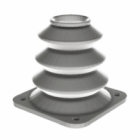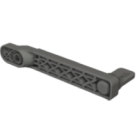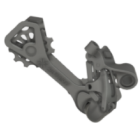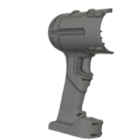3D printing materials guide
The material you choose is just as important as the printer itself. From common filaments like PLA and PETG to advanced resins, powders, and composites — each material has its own strengths, limitations, and ideal applications. This FAQ helps you understand the most widely used 3D printing materials, how they behave during printing, and what to consider in terms of durability, flexibility, surface finish, and sustainability.
The most commonly used material in 3D printing is PLA (Polylactic Acid), a biodegradable thermoplastic derived from renewable resources like corn starch. It’s popular due to its ease of use, low cost, and minimal warping, making it ideal for beginners and prototyping. PLA is primarily used with FDM printers and is available in a wide range of colors. While it’s not the strongest or most heat-resistant option, it remains the go-to material for general-purpose printing. For industrial applications, materials like PA12 (nylon) are more common.
PLA is usually the cheapest and most widely available material for FDM printers. For SLS, PA12 is cost-effective when printing large batches, thanks to material reusability.
The best material for 3D printing depends on your application — PLA is great for ease of use and prototyping, while PETG offers better durability and chemical resistance. For strong, functional parts, ABS or nylon (PA12) are widely used in both FDM and SLS technologies. If you need high-performance materials, PEEK or carbon fiber composites provide exceptional strength and heat resistance. Each material has its own balance of cost, strength, flexibility, and printability, so the ideal choice varies with project requirements.
PLA is biodegradable and easy to print, ideal for concept models. ABS offers better heat resistance and durability but needs a controlled environment. PETG combines strength and flexibility and is popular for functional, moisture-resistant parts.
Thermoplastics like PLA or Nylon are melted and solidified during printing (FDM/SLS), while photopolymers are liquid resins cured by light in SLA or DLP processes.
Photopolymer resins are UV-curable liquids used in SLA, DLP, and MSLA technologies. They allow for extremely high-resolution prints with smooth surfaces. Different types include standard, tough, flexible, castable, and biocompatible resins.
PA12 (Nylon 12) is a high-performance polyamide known for strength, durability, and excellent chemical resistance. In SLS printing, it enables the creation of strong, functional prototypes and production-ready parts without the need for support structures. It’s used extensively in automotive, aerospace, and industrial applications.
The strength of 3D printed materials varies widely depending on the technology, material type, and print settings. Industrial materials like PA12 (nylon) in SLS printing can produce parts with strength comparable to injection-molded plastics. FDM prints using materials like ABS or PETG are moderately strong but may show weaker inter-layer adhesion. Composite filaments with carbon fiber or glass fiber reinforcement can significantly improve mechanical performance. Overall, properly selected materials and optimized printing parameters can result in robust, functional parts suitable for demanding applications.
The strongest 3D printing materials include carbon fiber-reinforced nylon, PEEK, Ultem, and industrial-grade nylons like PA12 used in SLS.
Yes, TPU is a rubber-like thermoplastic used in both FDM and SLS printing. It offers excellent flexibility, shock absorption, and wear resistance. It’s commonly used for seals, gaskets, and wearables, though it requires tuning for optimal print quality.
Yes, materials like TPU offer rubber-like flexibility, while resins and polymers like PA11 Medical Grade or titanium alloys meet biocompatibility standards for medical use.
Absolutely. Materials like medical-grade PA11, biocompatible SLA resins, and titanium alloys are used for implants, surgical guides, and orthodontics. These materials comply with strict safety standards like ISO 10993 or USP Class VI, ensuring they can be safely used in clinical environments.
Yes, using technologies like DMLS or SLM, metal powders such as stainless steel, titanium, aluminum, and cobalt-chrome can be printed. Metal 3D printing allows for high-strength, complex components in aerospace, medical, and tooling industries. However, it requires specialized equipment and post-processing.
Yes, SLS printing allows for partial reuse of unsintered powder through a method called powder refresh. However, the refresh ratio must be managed carefully to maintain print quality and mechanical properties. Using too much recycled powder can degrade part performance.
There are eco-conscious options like recycled PETG, bio-based PLA, and composite filaments infused with wood or hemp fibers. Some SLS nylons can also be reused across multiple builds. Sustainability in 3D printing depends on material selection, print efficiency, and post-processing practices. More about sustainability in 3D printing.
Start by considering the required properties — strength, flexibility, heat resistance, surface finish, or biocompatibility. Match those needs to the appropriate technology (FDM, SLA, SLS, or metal). Also factor in budget, post-processing time, and environmental conditions.
Some 3D printing materials are recyclable, but the process isn’t always simple. Common filaments like PLA and PETG can technically be recycled, but they often require specialized recycling systems to ensure quality and consistency in re-use. Industrial powders (e.g., for SLS) can often be partially reused in new builds if properly filtered and refreshed. However, repeated use may degrade material properties, so recycling must be carefully managed.
Explore also
- 3D printing basics explained
- Choosing the right 3D printing technology
- Software & tools for 3D printing
- Costs, time & practical considerations
- 3D printing market & capabilities
Related categories













